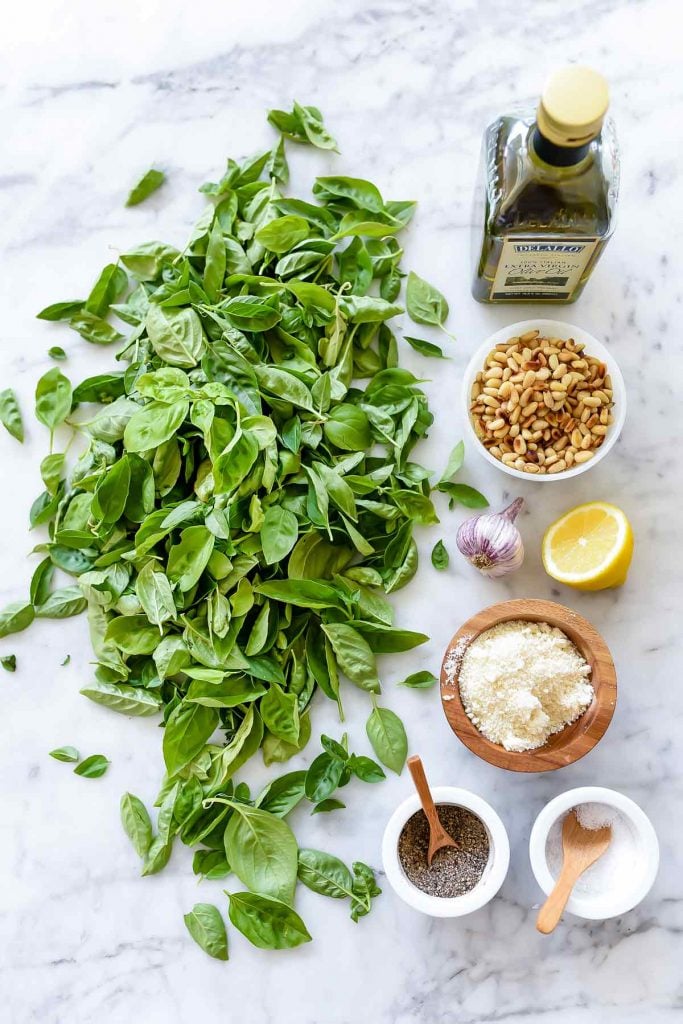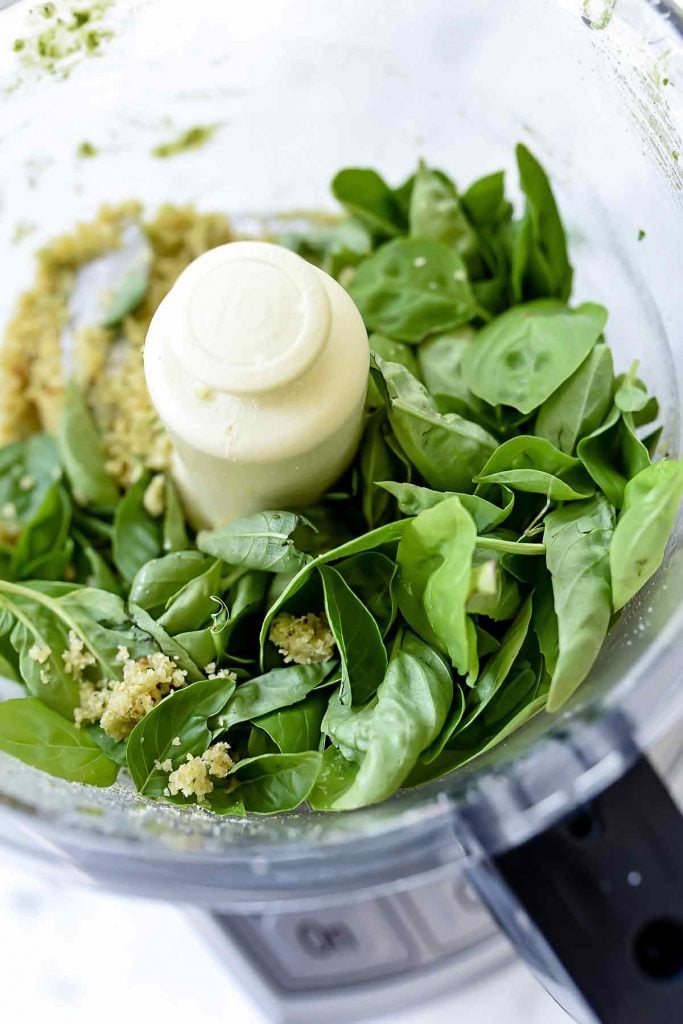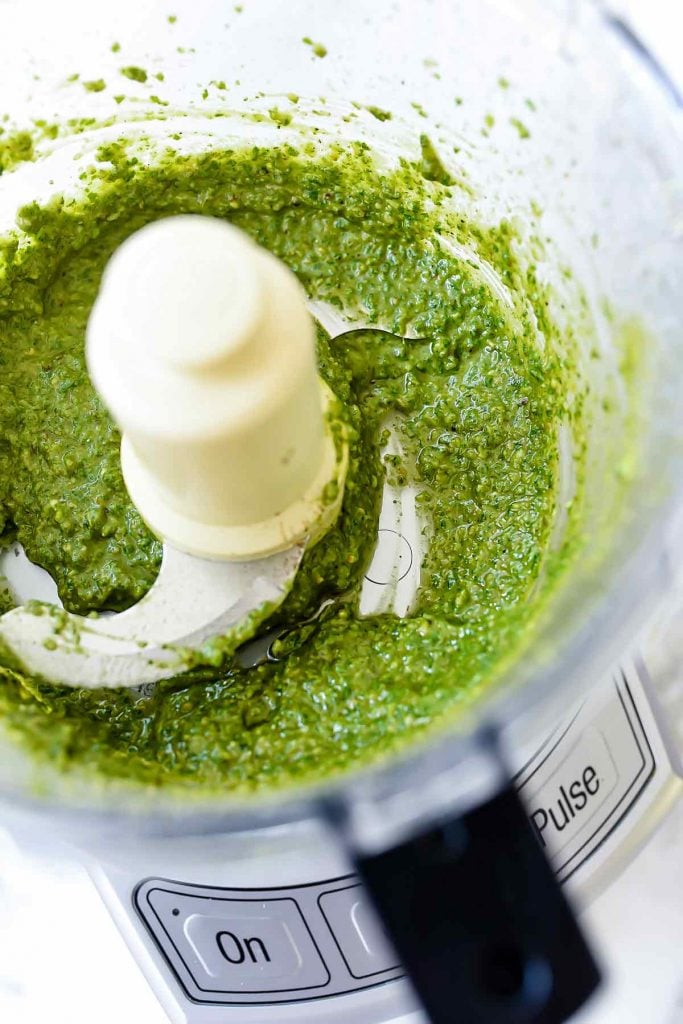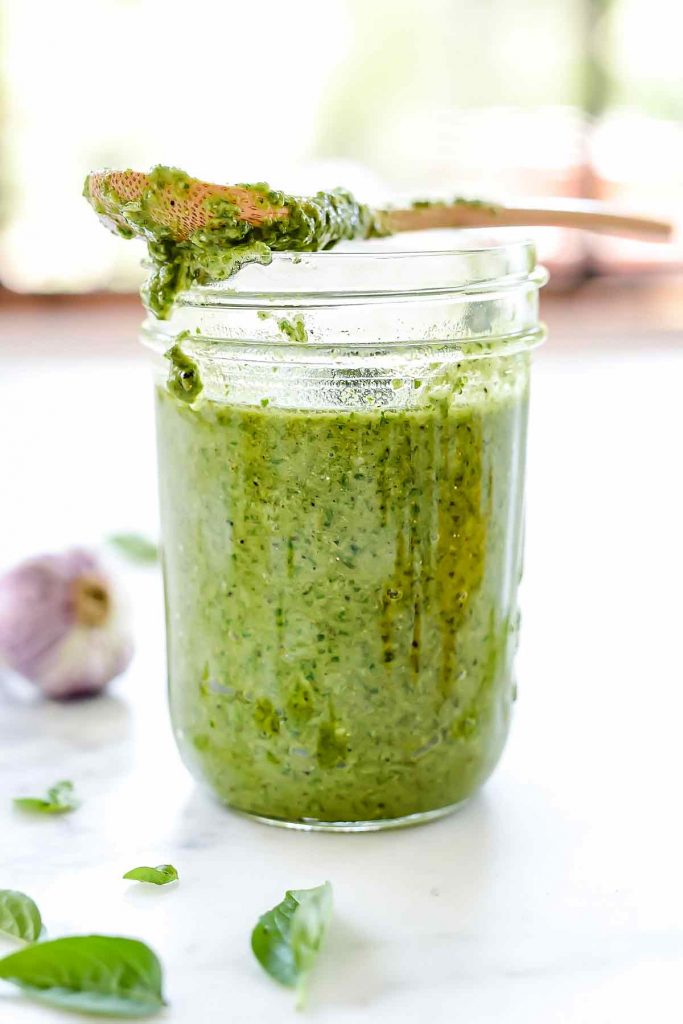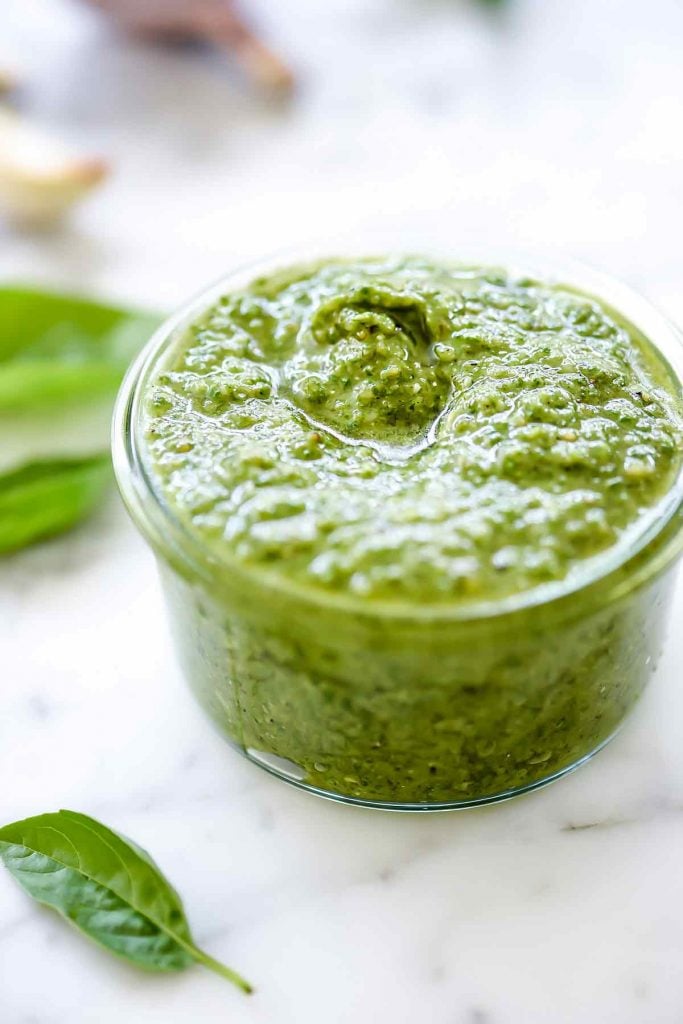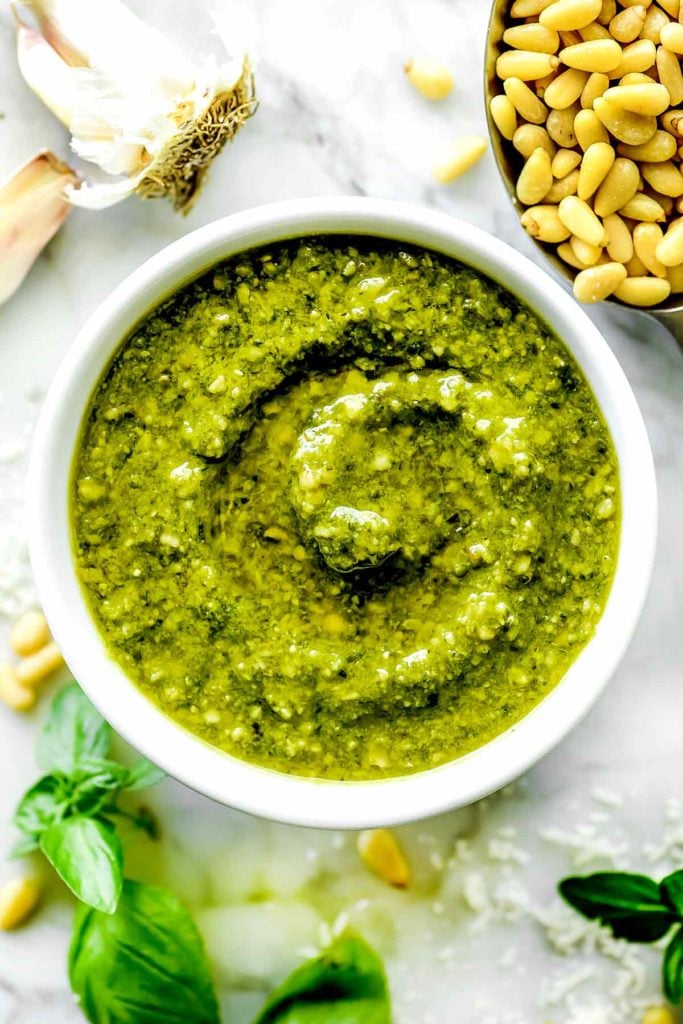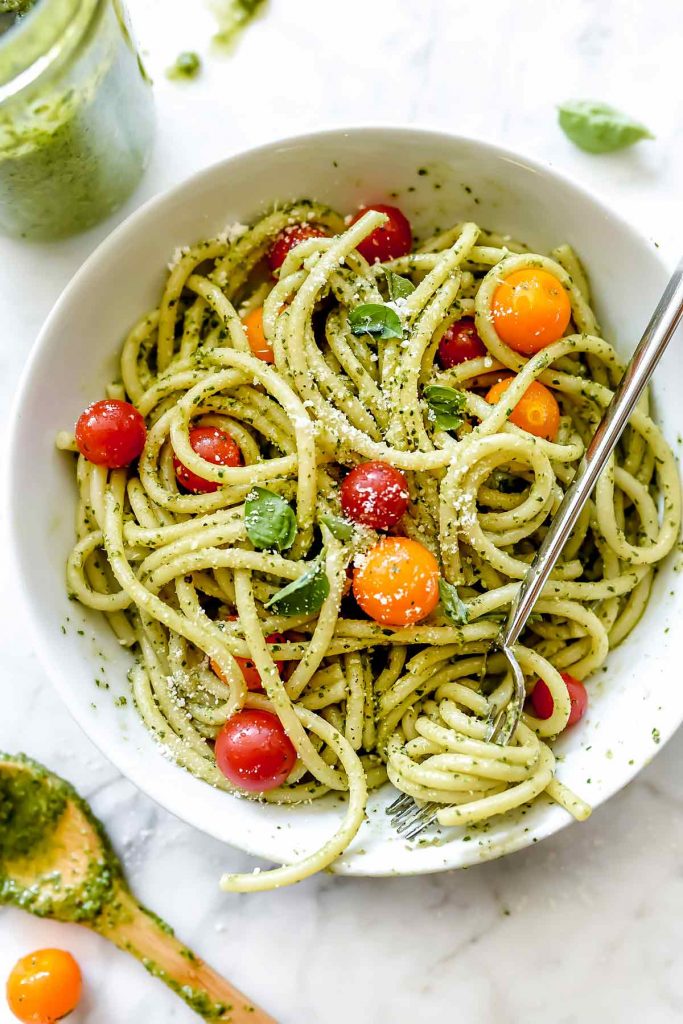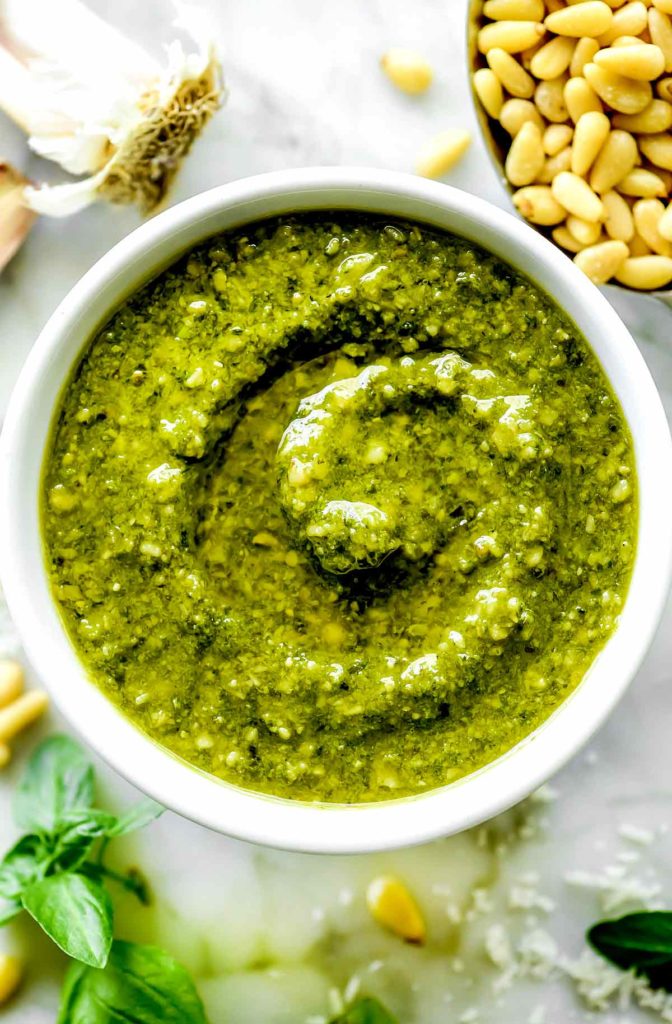
This easy homemade pesto recipe is my tried and true method to make THE BEST basil pesto recipe every single time.
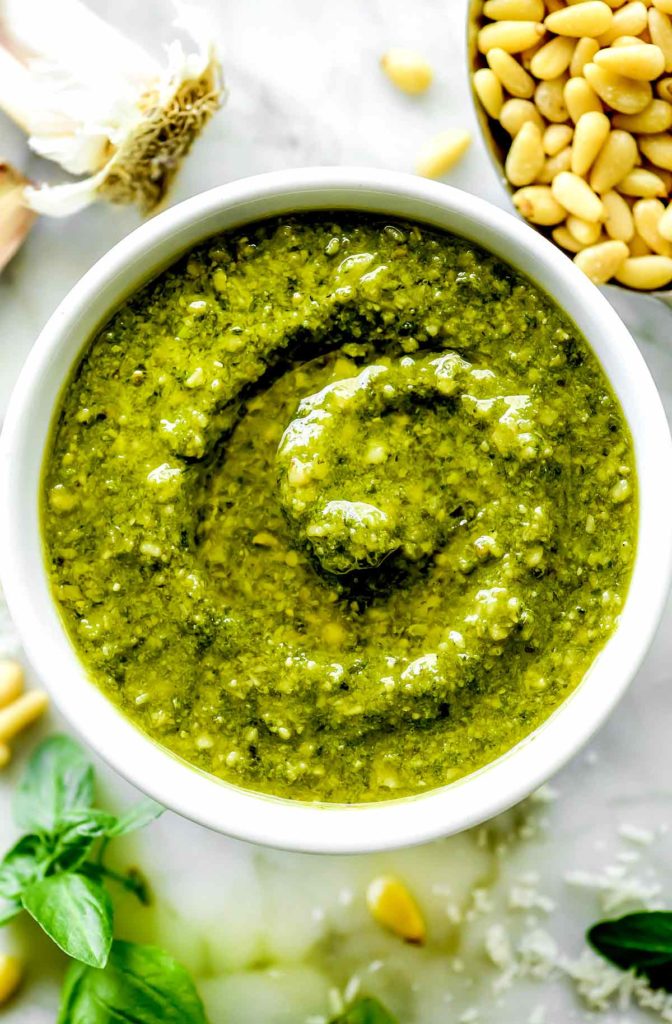
How to Make the BEST Pesto Recipe
From caprese chicken to pizza and even to mixing pesto with eggs or macaroni and cheese, this easy basil pesto recipe is one of the quickest ways to brighten any dish. I’m a big fan of the fact that homemade pesto is one of those recipes where you can sub different ingredients and get a distinct but familiar flavor.
This pesto is extra easy because I make it in the food processor. But here’s the deal: The secret sauce for the best pesto is all about the proportion of ingredients. Add too much garlic or not enough olive oil and pesto can go from great to gag in a hot minute. Trust me. I know.
But I’ve got you covered. My trial and error is your shortcut to making the best, easy, homemade basil pesto sauce you’ll be loving all year long. Just try it. I know you’ll like it.
What Is Pesto Made Of?
Classic pesto, or pesto alla genovese, is a simple, no-cook sauce that originated in Genoa, Italy and is popular on nearly any type of pasta, drizzled on pizza, on crusty bread, or as a topping for your favorite protein.
Each of the ingredients that make up this bright sauce plays a very important part, so choosing the best quality you can find is key to the best tasting herby sauce.
Here’s what pesto is a made of:
- Pine nuts or other fatty nut
- Grated hard Italian cheese such as or Parmesan or pecorino cheese
- Garlic
- Fresh basil leaves
- Kosher salt
- Good, fruity extra virgin olive oil
- Squeeze of fresh lemon juice
THE BEST Pesto Recipe Ingredients
Choose fresh leafy basil. My summer garden provides plenty of fresh basil leaves, and that’s why you’ll find me making this sauce all summer long. But I don’t stop there. During the winter months, I buy a containers of fresh basil I put in a pot to grow on my kitchen counter for a bit of freshness all winter long.
Should you blanche basil before making pesto? I’ve read tips of blanching the basil before adding it to the mixing process to reserve the vibrant green hue. I tried it, but discovered it didn’t matter much in the color department and the basil lost some of it’s flavor. So I don’t bother with that step.
Toast the pine nuts to deepen their nutty flavor. Place the pine nuts in a dry skillet or fry pan over medium high, and cook for a few minutes or until you can smell their toasted aroma, shaking the pan or stirring as they cook. Be sure to keep a watchful eye. I’ve burned more nuts than I can count because these babies turn from lightly toasted to burned in just a few seconds. Immediately remove the nuts from the hot pan into a bowl or plate so they don’t continue to toast.
Use a fresh and fruity olive oil for the lightest flavor. A light extra virgin olive oil keeps this sauce tasting fresh and light, and when added slowly to the rest of the ingredients provides the perfect emulsion.
Add a hard, dry, Italian cheese to thicken the sauce. Parmesan or pecorino cheese gives this sauce body and a salty bite. I use finely grated or ground Parmesan from my deli counter. And at all costs, avoid the stuff in the green can.
Add a good squeeze of lemon juice. Acid keeps the color bright and add just a touch of acid to balance out the flavor.
How to Make Basil Pesto
I make this pesto recipe in the food processor. Blending this sauce in a food processor makes this recipe extra quick to make. I prefer using the food processor over a blender because the large bladed processor quickly minces the ingredients with just a smidge of clean up after.
So what about using a mortar and pestle? Sure! Absolutely do if you’re up for the arm workout. But for me, I go the lazy way and just hit the ON button instead.
For bright green pesto, add the basil AFTER processing the nuts and garlic. Similar to chopping basil with a dull knife, overworking the basil in the processor or in a blender will turn it dark where it was cut.
Here’s how to make the best pesto:
- Add the toasted pine nuts, Parmesan cheese, and garlic to the bowl of the food processor and process until finely minced.
- Add the basil leaves and process.
- While the processor is still running, slowly drizzle the olive oil through the chute.
- Season with kosher salt and a squeeze of fresh lemon juice.
How to Store Pesto
Eat the pesto straight away or store in a jar with a tightly fit lid for up to 1 week. If storing for later, add a generous drizzle of olive oil to the top of the pesto. This will form an oily seal so it doesn’t turn dark. Simply stir into the sauce before using.
Can You Freeze Pesto?
Pesto freezes beautifully, and this is a great option to keep in mind if you plan on making lots of pesto sauce this summer. Freeze the pesto in ice cube trays, then transfer to freezer-safe bags in the freezer for up to 3 months. If you store this easy pesto in larger containers, you’ll have to thaw the pesto out all at once. Just something to keep in mind!
What to Use In Pesto Beside Pine Nuts
While pine nuts are my favorite nut to use in pesto, they’re definitely more expensive than other varieties. There’s also been incidents of a condition called pine nut mouth, where some pine nut eaters develop a metallic taste in their mouth that makes everything taste like you’re sucking on a penny. Even worse, it lasts for days and up to 3 weeks. The cause is unknown but if you wish to steer clear of the possibility, there are plenty of other nut options for you to choose from.
Other types of nuts to use in pesto instead of pine nuts:
- Walnuts
- Almonds (I like marcona almonds)
- Cashews
- Pepitas
- Pistachios
- Sunflower seeds
- Hemp seeds (safe for nut-allergies)
- Tahini
What to Use in Pesto Besides Basil
While basil is the most traditional pesto ingredient, switching up what is in season or different flavor profiles can be fun to experiment with. Here are a few ideas for what to use instead of basil:
Parmesan Substitutes
Finely grated Parmesan cheese gives pesto it’s distinctive salty nutty bite, but it also acts as a thickener too. Use these cheeses in place of Parmesan if you want:
- Asiago
- Pecorino romano
- Grana padano
What to Eat With Pesto
Of course you can eat pesto with pasta, but why stop there? Pesto is a fab alternative to mayo, mustard, or even sour cream and is awesome mixed into mashed potatoes or eggs. Here are a few ideas to sub in for a tastier, herbalicious bite.
- Add pesto to scrambled eggs
- Dollop on a baked potato instead of butter
- Use as a spread instead of mayo for a turkey sandwich
- Make it a savory addition to your morning omelette or slather on avocado toast
- Mix with tuna for a Mediterranean-style salad on greens
- Plop into a creamy tomato soup with chunks of mozzarella cheese for a slurpy caprese soup
- Toss into white rice for an herbed version way better than what comes from the box
Pesto Recipes You Have to Make
Pesto is one of my favorite flavorings in so many recipes. It’s an all-in-one flavor enhancer with each mixable dollop.
If you make this recipe, please let me know! Leave a 
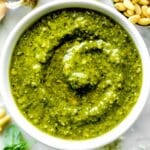
How to Make THE BEST Pesto
This easy homemade pesto recipe is my tried and true method to make THE BEST basil pesto recipe every single time.
Servings 16
Calories 102kcal
Ingredients
- 1/2 cup toasted pine nuts
- 1/2 cup fresh grated Parmesan cheese plus more for garnish
- 1 garlic clove roughly chopped
- 2 cups fresh basil leaves washed and stemmed and finely packed
- 1/2 cup olive oil
- 1/2 lemon juiced
- 1/2 teaspoon kosher salt
- 1/2 teaspoon freshly ground black pepper
Instructions
-
Add roughly chopped garlic, toasted pine nuts and finely grated parmesan cheese to the bowl of a food processor and process until smooth. Add the fresh basil leaves and pulse until chopped. .
-
While the processor is running, drizzle the olive oil through the shoot until the mixture is emulsified and smooth. Season with kosher salt, give it a squeeze of lemon juice, and whiz again
-
Taste for seasoning and adjust to your liking.
Notes
Eat the pesto straight away or store in a jar with a tight fitting lid for up to 1 week. If storing for later, add a generous drizzle of olive oil to the top of the pesto to form an oily seal so the pesto doesn’t turn dark. Simply stir the oil into the sauce before using.
Nutrition
Serving: 2tablespoons | Calories: 102kcal | Carbohydrates: 1g | Protein: 2g | Fat: 10g | Saturated Fat: 2g | Cholesterol: 2mg | Sodium: 123mg | Potassium: 42mg | Fiber: 1g | Sugar: 1g | Vitamin A: 185IU | Vitamin C: 2.4mg | Calcium: 44mg | Iron: 0.4mg
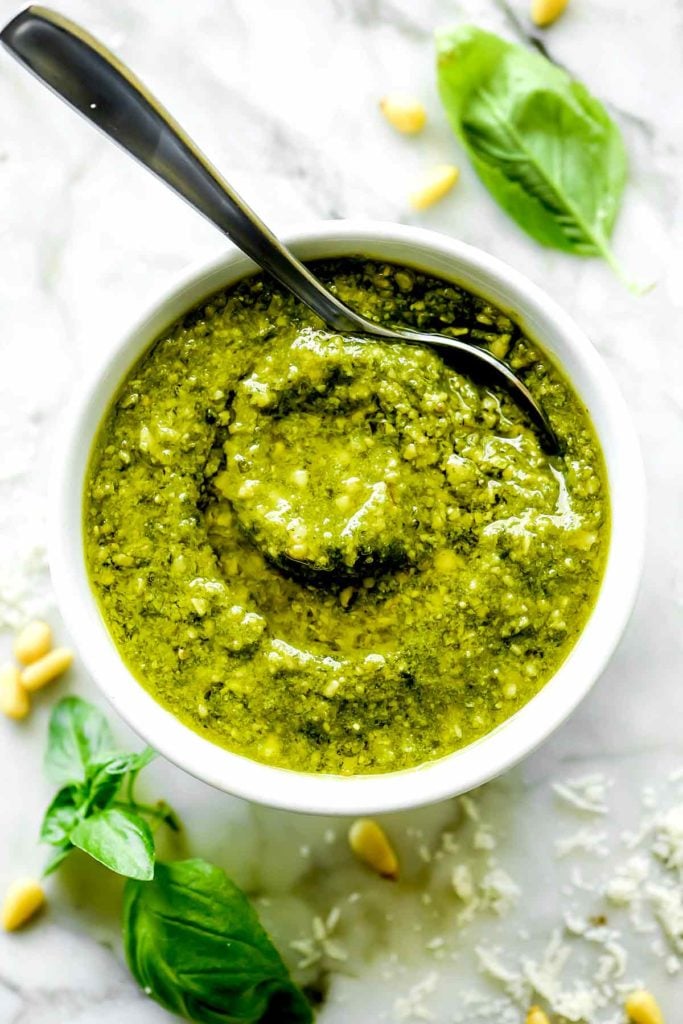
More Easy Italian Recipes You’ll Love
We send good emails. Subscribe to FoodieCrush and have each post plus exclusive content only for our subscribers delivered straight to your e-mail box.
Follow me on Instagram, Facebook, Pinterest and Twitter for more FoodieCrush inspiration.
As always, thank you for reading and supporting companies I partner with, which allows me to create more unique content and recipes for you. There are affiliate links in this post of which I receive a small commission. All opinions are always my own.

